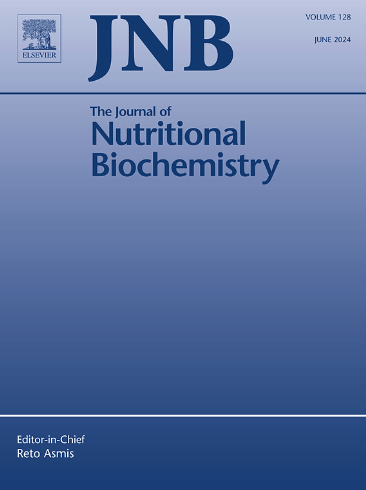Dietary addition of fraxetin improved intestinal structure and growth performance in juvenile grass carp (Ctenopharyngodon idella): As a potential novel phytogenic feed additive
IF 4.8
2区 医学
Q1 BIOCHEMISTRY & MOLECULAR BIOLOGY
引用次数: 0
Abstract
The well-being and development of fish are affected to varying degrees under the intensive aquaculture model, and the use of Chinese herbs for aquaculture disease control and feed additives has received increasing attention. This study examined fraxetin supplementation in juvenile grass carp to investigate its effects on growth and intestinal structure. There were 1080 grass carp (11.58±0.01 g) assigned to 6 treatments, fed with fraxetin (0, 3.9, 7.9, 15.8, 31.5, and 63.1 mg/kg) for 60 d in each treatment. In our study, appropriate fraxetin significantly increased final body weight (FBW), percent weight gain (PWG), and specific growth rate (SGR) compared to the unadded group (P<.05), but did not affect feed efficiency (FE) (P>.05). The administration of 7.9 mg/kg of fraxetin significantly improved fish intestinal development and body composition. Appropriate dietary fraxetin significantly enhanced intestinal digestive enzymes and brush border enzyme activity (P<.05), decreased serum diamine oxidase (DAO) levels (P<.05), and decreased intestinal cell apoptosis (P<.05). Appropriate levels of fraxetin inhibited the RhoA/ROCK signaling pathway while upregulating both mRNA and protein expression of tight junction (TJ) and adherens junction (AJ) (P<.05). These changes significantly improved apical junction complex (AJC) integrity. In conclusion, dietary supplementation with appropriate levels of fraxetin added to the diets had a facilitating effect on digestion and absorption, improved intestinal structure, and promoted fish growth performance in juvenile grass carp. In addition, the optimal dietary fraxetin levels were evaluated to be 6.06 and 7.79 mg/kg based on linear regression analysis of PWG and DAO, respectively.

饲料中添加黄曲黄蛋白可改善草鱼幼鱼肠道结构和生长性能,是一种有潜力的新型植物性饲料添加剂。
在集约化养殖模式下,鱼类的健康和发育受到不同程度的影响,中草药在水产养殖疾病防治和饲料添加剂中的应用越来越受到重视。本试验研究了在草鱼幼鱼中添加黄曲霉素对其生长和肠道结构的影响。试验选用草鱼1080尾(11.58±0.01 g),分为6个处理,分别饲喂黄曲霉素(0、3.9、7.9、15.8、31.5和63.1 mg/kg),每个处理60 d。在本研究中,与未添加组相比,适量添加黄曲素显著提高了末重(FBW)、增重率(PWG)和特定生长率(SGR) (P < 0.05),但对饲料效率(FE)无显著影响(P < 0.05)。7.9 mg/kg的黄曲黄蛋白显著改善了鱼的肠道发育和体组成。饲粮适当添加黄曲霉素显著提高了小鼠肠道消化酶和刷边酶活性(P < 0.05),显著降低了血清二胺氧化酶(DAO)水平(P < 0.05),显著降低了肠道细胞凋亡(P < 0.05)。适当水平的拉克西汀抑制RhoA/ROCK信号通路,上调紧密连接(TJ)和粘附连接(AJ) mRNA和蛋白的表达(P < 0.05)。这些变化显著改善了根尖连接复合体(AJC)的完整性。综上所述,饲料中添加适当水平的黄曲黄蛋白有利于草鱼幼鱼的消化吸收,改善肠道结构,促进鱼体生长性能。此外,通过PWG和DAO的线性回归分析,得出饲粮中拉黄蛋白的适宜水平分别为6.06和7.79 mg/kg。
本文章由计算机程序翻译,如有差异,请以英文原文为准。
求助全文
约1分钟内获得全文
求助全文
来源期刊

Journal of Nutritional Biochemistry
医学-生化与分子生物学
CiteScore
9.50
自引率
3.60%
发文量
237
审稿时长
68 days
期刊介绍:
Devoted to advancements in nutritional sciences, The Journal of Nutritional Biochemistry presents experimental nutrition research as it relates to: biochemistry, molecular biology, toxicology, or physiology.
Rigorous reviews by an international editorial board of distinguished scientists ensure publication of the most current and key research being conducted in nutrition at the cellular, animal and human level. In addition to its monthly features of critical reviews and research articles, The Journal of Nutritional Biochemistry also periodically publishes emerging issues, experimental methods, and other types of articles.
 求助内容:
求助内容: 应助结果提醒方式:
应助结果提醒方式:


